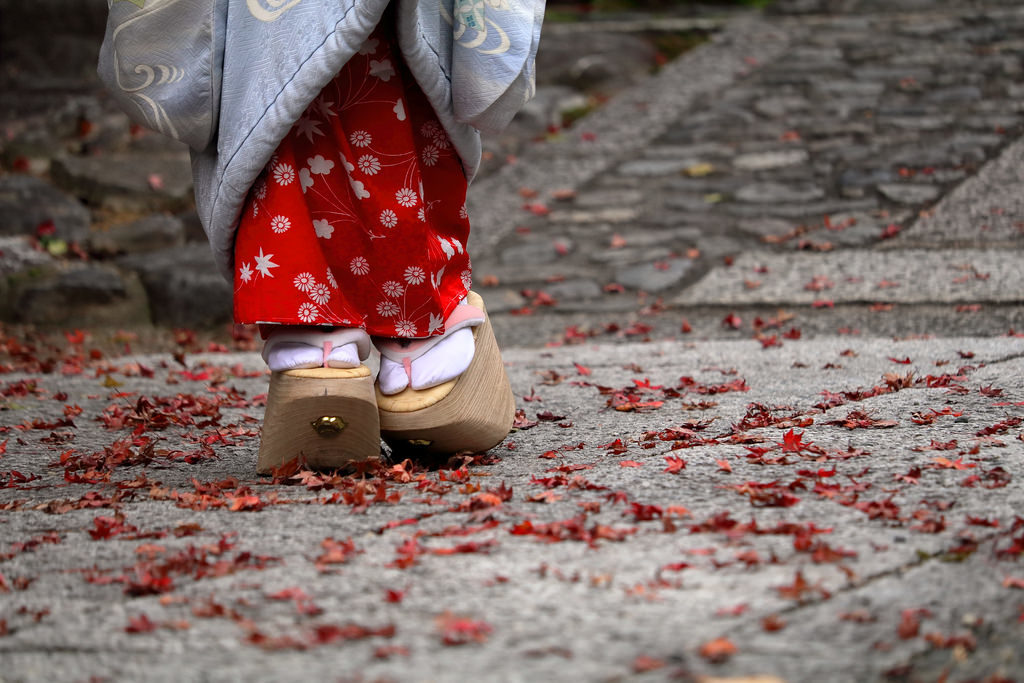As autumn comes and leaves’ tones turn slowly into orange and red, all of the Kyoto hanamachi get into a festive mood again. October is the month of the sophisticated dance recitals which, unlike April’s Miyako and Kyou Odori, are not that much “touristic”. In fact, most of the tourists may have no idea about these shows, and the audience mainly consists of conscious spectators connected with this unique world of art. Tickets are usually hard to obtain and, if you ask me, maybe it’s better this way. Autumn dances of the Old Capital guard the mysterious aura of the upscale Kyoto entertainment.

These performances are indeed exclusive and luxurious—they usually last from three to five days. For comparison, spring dances are performed almost every day for one whole month, and they are considered as the most stressful and busy time of the year for maiko and geiko. Significantly, autumn recitals don’t hold the names with a suffix for “dances” (odori/ をどり), but a refined kanji for “gathering”, “association”, and “party” (kai/ 会/會). Such term is nothing unusual in the world of performing arts. It merely indicates that both spectators and performers belong to the same club and fully understand the performance, its tidbits, and cultural background.
All of the annual geisha performances are based on classical kabuki and noh plays, literature, as well as folk songs and tales. It is essential to know even the most common ones to fully appreciate the whole show at each Kaburenjo. After all, autumn meetings at the local hanamachi theatres review and confirm the skills of the most excellent dancers, musicians, and art teachers around. Kotobukikai in Kamishichiken, Suimeikai in Pontocho, Onshukai in Gion Kobu, and Mizuekai in Miyagawacho allow the spectators to test the artists’ passion for the stage.

Unlike big Odori events, these exclusive shows engage only the most talented performers. The most delightful spectacle is performed by the oldest, yet the most experienced, geiko. Their precision, trained for years, is expressed in every movement and ability to tell a story through their body language. Performing on stage in autumn is a great honor for every geiko, as such engagement assures them of their own value as artists.
Even the youngest maiko are engaged to perform during the “-kai” events. Their presence, however, depends on the obtained skills. What is remarkable though, all of the maiko wear unified outfits then. For the youngest ones then, the engagement is a real priviledge—they can actually try to paint both of their lips red and wear white collars for the first time, typically, the symbols of maturity.

The end of the month brings another bunch of special events. In November, maiko and geiko of Gion Higashi prepare the only one dance recital of this district—Gion Odori. Colorful maple leaves on the booklets and stage indicate the magnificent and warm feeling of Kyoto’s autumn season. Although it’s a typical odori performance, Gion Odori is held for about ten days only. It is also very elegant, yet more casual gathering in comparison to the “-kai” recitals. You can spot inside the theatre, of course, a lot of stylish people dressed in kimono, but an atmosphere of the performance itself happens to be cheerful and relaxed.

A grain of practical information: tickets for the “-kai” performances cost twice more the tickets for annual odori events. The price does not include the tea ceremony, as this custom is not practised by geiko and maiko then. Performances start in the afternoon—usually at 13:00 or 16:00. Tickets are usually available at the theatres or online for the events listed below:
- Kotobukikai in Kamishichiken – http://www.maiko3.com/event/ev-8.html
- Suimeikai in Pontocho – http://www.kamogawa-odori.com/suimeikai/
- Onshukai in Gion Kobu – http://www.miyako-odori.jp/onsyukai/
- Mizuekai in Miyagawacho – http://www.miyagawacho.jp/mizuekai/

Thank you for this article! The detail about the difference of ‘kai’ and ‘odori’ was very interesting.